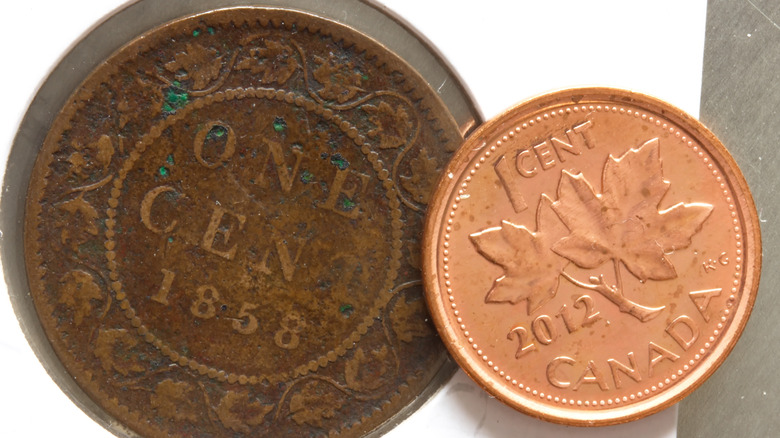A Rare Canadian Penny Known For Its Large Size Could Be Worth A Ton Of Money
The 1858 Canadian Large Cent is a piece of history marking some of Canada's early steps towards creating its own currency. Before Canada had its own mint, which wasn't founded until 1908, the majority of the country's coins were either made in England or were foreign forms of currency and colonial notes. However, the Currency Act of 1857 changed all of that, opening the doors for the first Canadian cents to be created. This is part of why the 1858 Canadian Large Cent isn't just a coin; it's a rare collector's gem, with just 421,000 ever minted. Finding one in top condition today can be like stumbling upon a hidden treasure, but the appeal of this coin goes beyond its mere scarcity. It represents a pivotal piece of Canadian history — the shift from being a colony dependent on mixed foreign currencies to establishing its own monetary system.
The 1858 Large Cent is also hefty compared to today's coins. It's 1 inch in diameter, which is about 25% bigger than Canadian pennies today — although it's worth mentioning that Canada discontinued production of its penny in 2012 because, much like the U.S., the penny costs more to make than it's worth. Made of bronze, the coin also weighs in at 5.67 grams (the weight of a U.S. quarter). On the front, it features a portrait of Queen Victoria, crafted by Leonard Charles Wyon, and the back is adorned with a wreath of maple leaves encircling the denomination.
Value of the 1858 Large Cent
Any valuable coin — even coins you might find in your spare change — will have different values depending on condition, historical significance, and rarity. Also, a unique background can similarly boost a coin's value. Many of these factors were at play when a near perfect 1858 Canadian Large Cent fetched over $21,000 at a 2019 auction. While 421,000 of these coins were made, finding one in good shape today is rare, with most having been worn down from years of use.
To grade this particular coin's condition, collectors will dig into details like how well the maple wreath's leaf tips, or Queen Victoria's laurel wreaths, have held up — details that tend to fade and smooth with long-term handling. However, fake coins are also a problem. There are many examples of people trying to sell counterfeit 1858 Large Cents online. This is why having your coins professionally graded is particularly important. The value of any 1858 Canadian Large Cent largely hinges on third-party grading – and coins that are graded tend to fetch higher prices at auctions.
Identifying authentic coins from replicas
Ensuring your coin is authentic can be an extremely important step. To start, you should only buy coins from trustworthy dealers, auctions, or recognized numismatic groups. Next, get your coins graded professionally by reputable firms like NGC or PCGS. These experts can confirm a coin's authenticity, check its condition, and even seal it in a tamper-proof holder. Graders look closely at signs of wear, shine, and how well the coin was struck — details that can make the difference between a coin worth a couple hundred dollars and one that's worth $21,000. Also, quirks like minting errors — die cracks, off-center strikes, or faint details on the back — can seriously improve a coin's allure and value, sometimes doubling or even tripling it.
True 1858 Canadian Large Cents can also be more easily identified by their exact weight (5.67 grams), diameter (25.4 mm), and even clear design details — like the maple leaf wreath and the intricate details of Queen Victoria's laurel wreath. Counterfeits might have an off color, blurry edges or letters, or they might simply not look right. Another thing to remember is that storing your coins can be crucial. Common PVC plastic can lead to corrosion, so using archival-quality holders can be key. Plus, making sure to keep the humidity steady between 30% and 40%, and the temperature below 71 degrees Fahrenheit. Also, when you need to handle your coins, remember to wear cotton gloves and to never clean a coin since cleaning can cause scratches that permanently lower its value.


